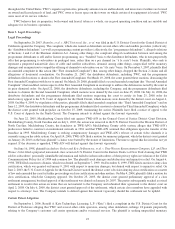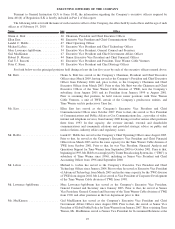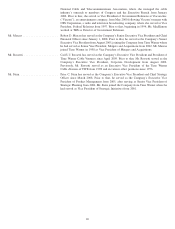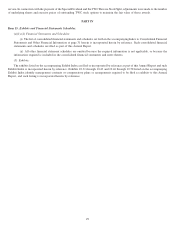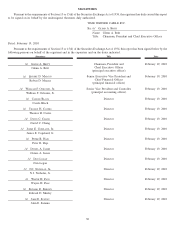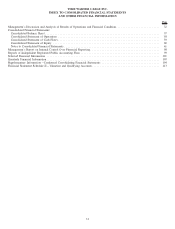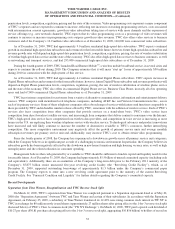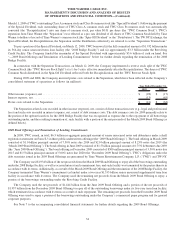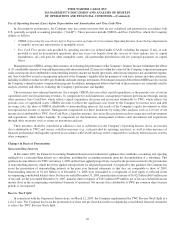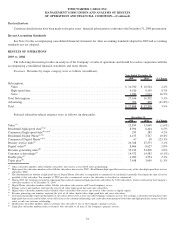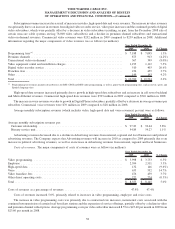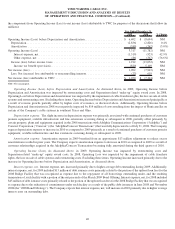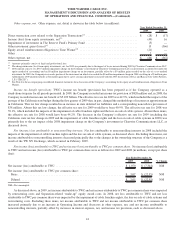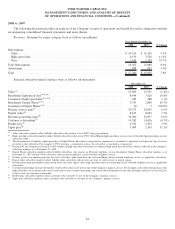Time Warner Cable 2009 Annual Report Download - page 44
Download and view the complete annual report
Please find page 44 of the 2009 Time Warner Cable annual report below. You can navigate through the pages in the report by either clicking on the pages listed below, or by using the keyword search tool below to find specific information within the annual report.TIME WARNER CABLE INC.
MANAGEMENT’S DISCUSSION AND ANALYSIS OF RESULTS
OF OPERATIONS AND FINANCIAL CONDITION
INTRODUCTION
Management’s discussion and analysis of results of operations and financial condition (“MD&A”) is a supplement to the
accompanying consolidated financial statements and provides additional information on Time Warner Cable Inc.’s (together with its
subsidiaries, “TWC” or the “Company”) business, current developments, financial condition, cash flows and results of operations.
MD&A is organized as follows:
•Overview. This section provides a general description of TWC’s business, as well as recent developments the Company
believes are important in understanding the results of operations and financial condition or in understanding anticipated future
trends.
•Financial statement presentation. This section provides a summary of how the Company’s operations are presented in the
accompanying consolidated financial statements.
•Results of operations. This section provides an analysis of the Company’s results of operations for the three years ended
December 31, 2009.
•Financial condition and liquidity. This section provides an analysis of the Company’s cash flows for the three years ended
December 31, 2009, as well as a discussion of the Company’s outstanding debt and commitments that existed as of December 31,
2009. Included in the analysis of outstanding debt is a discussion of the amount of financial capacity available to fund the
Company’s future commitments, as well as a discussion of other financing arrangements.
•Market risk management. This section discusses how the Company monitors and manages exposure to potential gains and
losses arising from changes in market rates and prices, such as interest rates.
•Critical accounting policies and estimates. This section discusses accounting policies and estimates that require the use of
assumptions that were uncertain at the time the estimate was made and that could have a material effect on the Company’s
consolidated results of operations or financial condition if there were changes in the estimate or if a different estimate was made.
The Company’s significant accounting policies, including those considered to be critical accounting policies and estimates, are
summarized in Note 3 to the accompanying consolidated financial statements.
• Caution concerning forward-looking statements. This section provides a description of the use of forward-looking information
appearing in this report, including in MD&A and the consolidated financial statements. Such information is based on
management’s current expectations about future events, which are inherently susceptible to uncertainty and changes in
circumstances. Refer to Item 1A, “Risk Factors” in Part I of this report, for a discussion of the risk factors applicable to
the Company.
OVERVIEW
TWC is the second-largest cable operator in the U.S., with technologically advanced, well-clustered systems located mainly in five
geographic areas – New York State (including New York City), the Carolinas, Ohio, southern California (including Los Angeles) and
Texas. As of December 31, 2009, TWC served approximately 14.6 million residential and commercial customers who subscribed to one
or more of its three primary subscription services – video, high-speed data and voice – totaling approximately 26.4 million primary
service units (as defined in “Results of Operations”).
As discussed further in “—Recent Developments,” on March 12, 2009, TWC completed its separation from Time Warner Inc.
(“Time Warner”), which, prior to the Separation Transactions (as defined below), owned approximately 84% of the common stock of
TWC (representing a 90.6% voting interest) and a 12.43% non-voting common stock interest in TW NY Cable Holding Inc. (“TW NY”),
a subsidiary of TWC. As a result of the separation, Time Warner no longer has an ownership interest in TWC or TW NY.
TWC offers video, high-speed data and voice services over its broadband cable systems to residential and commercial customers.
TWC markets its services separately and in “bundled” packages of multiple services and features. As of December 31, 2009, 57.3% of
TWC’s residential and commercial customers subscribed to two or more of its primary services, including 23.7% of its customers who
subscribed to all three primary services. TWC also sells advertising to a variety of national, regional and local advertising customers.
Video generates the largest share of TWC’s revenues and, as of December 31, 2009, TWC had approximately 12.9 million video
subscribers, of which approximately 8.9 million received digital video signals. Although TWC expects to continue to lose video
subscribers as a result of increased competition, TWC believes it will continue to increase video revenues for the foreseeable future
through the offering of incremental video services (e.g., digital video recorder services and additional programming tiers), as well as
through equipment rentals and price increases; however, future video revenue growth rates will depend on video subscriber and
32



